UK Inflation Forecast, Will RPI Deflation Return to Inflation?
Economics / Inflation Sep 23, 2009 - 02:25 AM GMTBy: Nadeem_Walayat
 UK RPI Inflation data of minus 1.3% for August 09 continues to show deflation moderating from the June low of -1.6%. Whilst the Governments preferred CPI inflation measure recorded a slight dip to 1.6% from 1.8% dipping further below the Bank of England's target rate of 2%.
UK RPI Inflation data of minus 1.3% for August 09 continues to show deflation moderating from the June low of -1.6%. Whilst the Governments preferred CPI inflation measure recorded a slight dip to 1.6% from 1.8% dipping further below the Bank of England's target rate of 2%.
RPI deflation in the face of panic interest rate cuts from 5% at the beginning of October 2008 to just 0.5% by the last cut of March 2009, coupled with unprecedented quantitative easing aka "money printing" to drive down long-term interest rates and hence mortgage rates resulted in deflation for those with large mortgages of as much as minus 5%, therefore this as I mentioned some 4 months ago would provide for a for mini 'temporary' cash flow boost for those mortgage holders that have secure employment during the recession and therefore contributing to the summer bounce in house prices that has now transpired and looks sent to continue into the end of the year and therefore contribute towards upward pressure on consumer prices.
However the temporary bounce in house prices needs to be set against the bursting of the asset bubble that has seen UK house prices fall by 21% from the peak of August 2007. UK deflation in the face of the bursting of the asset bubble has now hit the deflation targets for 2009 and therefore the expectation is for the trend to start reversing back towards inflation over the coming months with signs that RPI has already bottomed out and the CPI warning of gathering inflationary clouds as the gap between RPI and CPI Inflation hit extreme levels during mid year which now looks set to narrow.
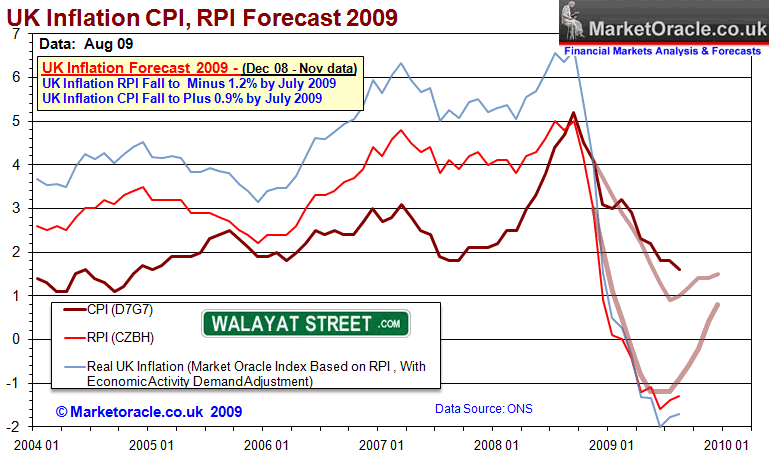
The trend in inflation data remains inline with my original forecast as of Dec 08 that forecast deflation into mid 2009, followed by a slowly rising inflationary trend during the second half of 2009. RPI of -1.3% will also have the effect of depressing wages as this measure is used to determine pay deals therefore continuing deflation throughout 2009 despite money printing which suggested overshoot on RPI to the downside that has come to pass.
My recent article Bailed Out Banks Not Lending, Sitting on Tax Payers Cash, illustrated why quantitative easing is not resulting in run away inflation that many gold bugs have been hoping for as basically the banks are refusing to take risks and instead using tax payer cash to earn interest on deposits at the Bank of England.
UK Money Supply - Deflation
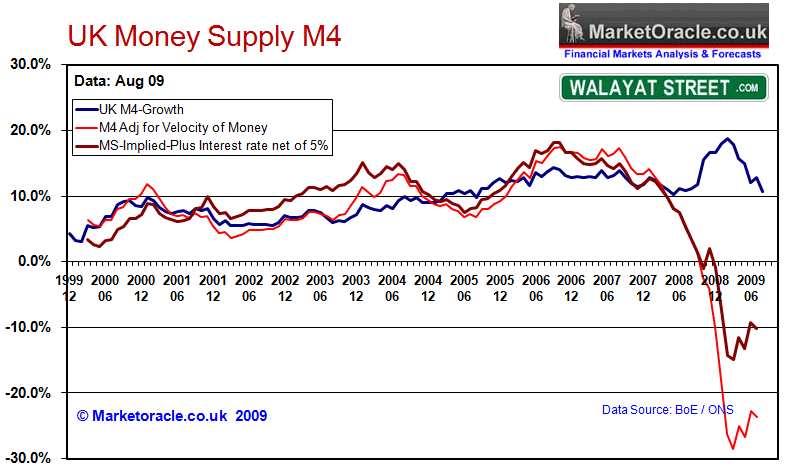
Whilst UK Money supply M4 (blue) remains at a high 10% off of its earlier high of 17.7%, on face value this is highly inflationary and has been taken by some economists and market commentators to suggest much higher forward inflation. However the money supply adjusted for the velocity of money which takes into account the state of the economy as a consequence of the credit crisis tells a completely different story. The UK economy remains in extreme real monetary deflation of approaching -25%. Both this and the leading indicator of the implied money supply, are suggesting that the deep interest rate cuts to just 0.5% and quantitative easing of £175 billion have halted the economic collapse into out of control deflation, but we are far from a state of entering a high inflation environment which therefore continues to suggest strong deflationary pressures for rest of 2009 and into 2010.
Budget Deficit and Quantitative Easing
Virtually all of the mainstream press swallowed the Bank of England's hints and winks that Quantitative Easing had ended at £125 billion. All except myself that projected towards Quantitative Easing of £300 billion by the end of this year with the current tally now standing at £175 billion of money printed so as to mainly buy government bonds in response to the huge budget deficit that the Labour government will rack up by the end of this year that projects to £175 billion which is up from Alistair Darlings projection of £38 billion in November.
The outlook for subsequent years also remains for bleak with deficits expected to continue for many years as Alistair Darlings own forecast for government net borrowing over the next 4 years has grown from a deficit of £120 billion in November 2008 to £608 billion as of the budget, which is still significantly below my forecast total of £735 billion and therefore the expectation remains for further revisions to the upside over the coming years. This confirms my view that the Bank of England will continue printing money into year end to beyond the £175 billion revised arrangement though probably less than the £300 billion suggested some 10 months ago. Which on face value is both inflationary and supportive of the economic bounce.
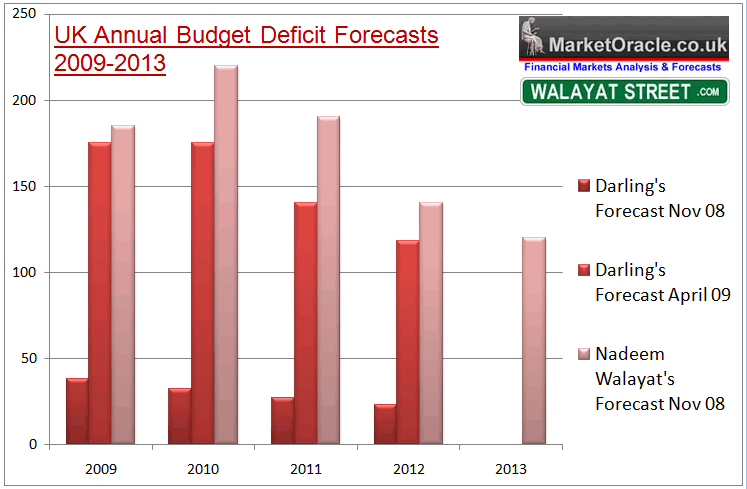
Engineering an Election 'Winning' Economic Recovery
The forecast date for the next General Election as of October 2007 has been for May 2010, with the projected seats implying a small Conservative victory of a majority of 36. Clearly all is not lost for the Labour government, therefore the primary aim now is to reduce this projected small majority by as much as possible if not to totally eliminate it, to achieve this the government has thrown ALL of the fiscally responsible rules out of the window starting last October having embarked on a programme of maximising the number of seats Labour will retain at the next general election. One of the key milestones set by the Prime Minister Gordon Brown of achieving this objective is in successfully and publically achieving a strong economic bounce into May 2010. My on going analysis confirmed a bounce into a May 2010 general election as long ago as February 2009, with more recent analysis confirming this outlook (UK Economy Set for Debt Fuelled Economic Recovery Into 2010 General Election)
Whilst the OECD and other mainstream organisations / press have been busy in recent months revising their economic forecasts, my forecast remains as is and continues to project towards post general election tax hikes and deep public spending cuts that will in my opinion trigger a double dip RECESSION, even DEPRESSION 2011 to 2012 as illustrated by the graph below.
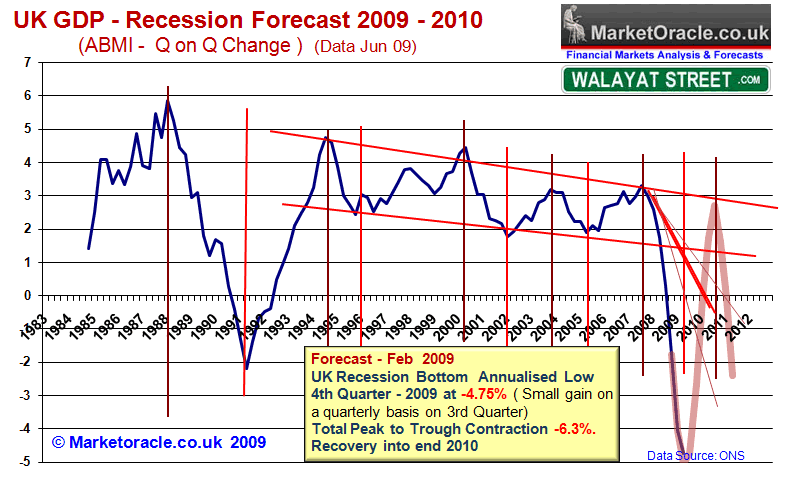
Deflationary Impact of Rising Unemployment
The original forecast of October 2008 (July 08 data) as illustrated by the below graph, forecast UK unemployment to hit 2.6 million by April 2010. The actual data to date of 2.47 million to July 2009 clearly continues to suggest a much higher peak which remains on track to hit 3 million, as unemployment tends to lag economic recoveries by anywhere from between 6 to 12 months.

A poignant reminder of the lack of accuracy in the official unemployment data is observed in the announcement that 1 in 6 households have no wage earner, i.e. all adults are unemployed in a total 3.3 million households, which clearly suggests a number of unemployed significantly above the 2.47 million official data of those unemployed. The rising number of unemployed will continue to exert deflationary pressure on the economy.
UK House Prices Against Unemployment Trend Analysis
The original forecast of August 2007 concluded with a forecast drop in UK house prices of between 15% and 25% by August 2009, which has materialised.
August 2007 Forecast Conclusion - The UK Housing market is expected to decline by at least 15% during the next 2 years. Despite the 2012 Olympics, London is expected to fall as much as 25%. UK Interest rates are either at or very near a peak, as there is an increasingly diminishing chance of a further rise in October 2007. After which UK interest rates should be cut as the UK housing market declines targeting a rate of 5% during the second half of 2008. The implications for this are that the UK economy is heading for sharply lower growth for 2008
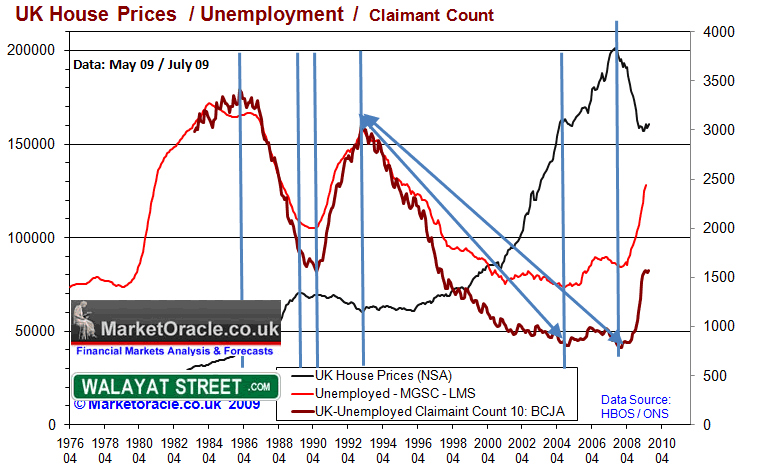
The above chart indicates that there does exist a strong relationship between house price trends and the unemployment benefit claimant count, more so than the unemployment data. The possible reason for this is that those made unemployed that do not claim benefits are not in as financially distressed state than those that have no choice but to claim benefits, therefore house prices can and have risen in the past whilst the official rate of unemployment rose, if at the same time the claimant count did not rise.
The on going bounce in house prices is tracking quite closely with the stabilisation of the unemployment claimant count numbers, which therefore suggests that as long as those claiming unemployment benefits continues to stabilise at the current level of 1.6 million then the outlook remains positive for UK house prices to continue drifting higher, this is despite official unemployment data that looks set to continue to rise towards 3 million from 2.47 million.

Summer Bounce 2009 - The unfolding bounce in UK house prices prices is inline with my May analysis that concluded that UK house prices will experience a bounce during the summer months from extremely oversold levels as a consequence of liquid buyers returning to the market and the debt fuelled economic recovery which 'should' be reflected in rising house prices during the summer months that is increasingly being taken by the mainstream press and vested interests to announce that the house prices have bottomed, my next analysis will seek to expand on house price expectations during 2010.
UK Interest Rates
The existing base interest rate forecast as of December 2008 is for UK interest rates to resume an upward curve towards the end of this year as a consequence of the debt fuelled economic recovery into a projected May 2010 General Election as illustrated by the below graph. UK interest rates hit bottom in March 2009 with the subsequent trend to date suggesting an unchanged base rates into late 2009.
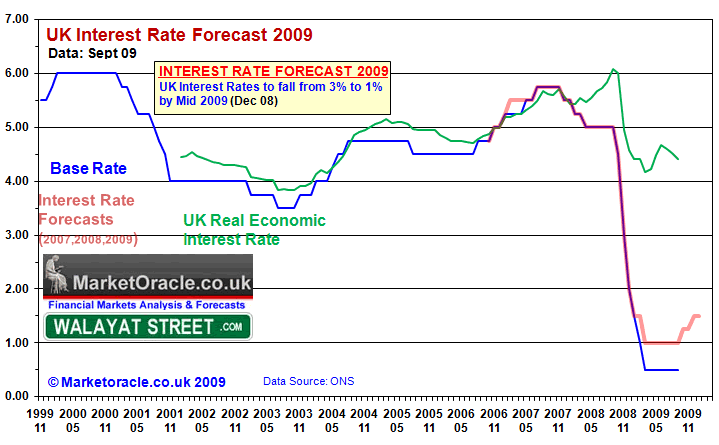
However real interest rates have been in a steady climb since March 2009 which has increasingly meant that the base interest rate has become irrelevant to the market place as explained in the article - Bailed Out Banks Not Lending, Sitting on Tax Payers Cash.
The outlook remains for rising market interest rates charged to retail customers regardless of the base rate being held at 0.5% into the end of the year, which is inflationary in terms of rising mortgage costs.
UK Inflation Conclusion - The trend into Extreme UK Deflation as measured by RPI has come to an end, forward inflation is expected to rise at a subdued rate as result of the economic recovery into the 2010 general election with RPI targeting +1% so Yes RPI Deflation will come to an end, but thereafter the high risk of a double dip recession expectation suggests the shallow uptrend in inflation will come to a halt during 2010 despite further quantitative easing and arm twisting of the banks to LEND into 2010 as the Bank of England attempts to increase the velocity of money by all means with even the option of negative interest rates to force the banks to take risks rather than park their tax payer bailout money at the BoE to earn risk free interest on.
In summary, I see no signs of a return to high inflation during the balance of 2009 or the whole of 2010, with the CPI trend expected to hover around the BoE 2% target. I will produce an inflation forecast chart for 2010 later this year.
Ensure that you are subscribed to my always free newsletter to receive in depth analysis on UK house prices and also in the works a forecast for the UK economy covering the next 10 years.
By Nadeem Walayat
http://www.marketoracle.co.uk
Copyright © 2005-09 Marketoracle.co.uk (Market Oracle Ltd). All rights reserved.
Nadeem Walayat has over 20 years experience of trading derivatives, portfolio management and analysing the financial markets, including one of few who both anticipated and Beat the 1987 Crash. Nadeem's forward looking analysis specialises on the housing market and interest rates. Nadeem is the Editor of The Market Oracle, a FREE Daily Financial Markets Analysis & Forecasting online publication. We present in-depth analysis from over 400 experienced analysts on a range of views of the probable direction of the financial markets. Thus enabling our readers to arrive at an informed opinion on future market direction. http://www.marketoracle.co.uk
Disclaimer: The above is a matter of opinion provided for general information purposes only and is not intended as investment advice. Information and analysis above are derived from sources and utilising methods believed to be reliable, but we cannot accept responsibility for any trading losses you may incur as a result of this analysis. Individuals should consult with their personal financial advisors before engaging in any trading activities.
Nadeem Walayat Archive |
© 2005-2022 http://www.MarketOracle.co.uk - The Market Oracle is a FREE Daily Financial Markets Analysis & Forecasting online publication.



